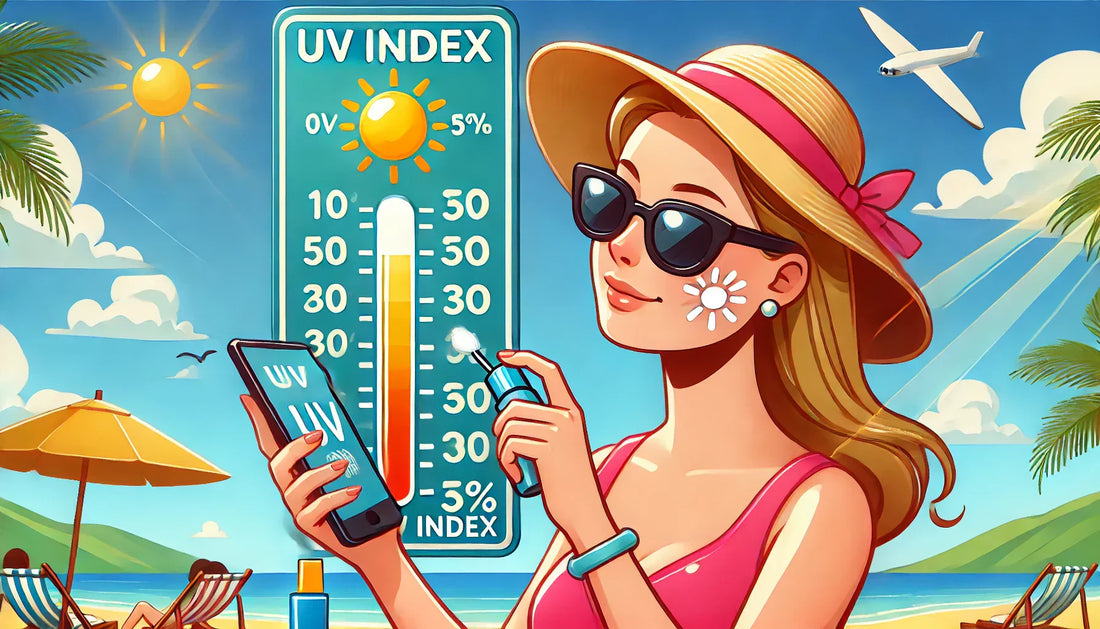
Understanding the UV Index
Spot My UV users all know that spending time in the sun has its benefits, from boosting our mood to helping our bodies produce vitamin D. Yet too much sun exposure carries risk and that’s where the UV index comes in. The UV index is a valuable tool that helps us understand when we need to be extra cautious about sun exposure. But what exactly is the UV index and how can we use it for better sun safety? Let’s dive in.
What is the UV Index?
The UV index is a scale that measures the intensity of ultraviolet radiation from the sun at a given time and place. It was developed by the World Health Organization (WHO), the World Meteorological Organization (WMO), and other health agencies to help people make informed decisions about sun exposure.
The UV index typically ranges from 0 to 11+ with higher values indicating a greater risk of harm from unprotected sun exposure. Here’s a general breakdown:
0-2 (Low): Minimal risk. Most people can stay outside safely with little protection.
3-5 (Moderate): Moderate risk. It’s advisable to wear sunglasses, use sunscreen, and seek shade during midday hours.
6-7 (High): High risk. Protection is essential - seek shade, wear protective clothing, and apply broad-spectrum sunscreen.
8-10 (Very High): Very high risk. Extra precautions are necessary - avoid prolonged exposure and use strong sun protection.
11+ (Extreme): Extreme risk. Unprotected exposure can quickly lead to sunburn and long-term skin damage.
Why is the UV Index Important?
Many people mistakenly associate the risk of sunburn with temperature alone. But UV radiation levels don’t necessarily correlate with how hot it feels outside. The UV index helps provide a more accurate measure of potential sun damage by taking into account the following variables:
Time of Day: UV radiation is strongest between 10 AM and 4 PM.
Geographical Location: The closer you are to the equator the stronger the UV rays.
Altitude: Higher elevations receive stronger UV radiation.
Season: UV levels are typically higher in spring and summer.
Weather Conditions: UV rays can penetrate clouds which means overcast days don’t always mean lower exposure.
Reflective Surfaces: Water, sand, and snow can intensify UV exposure by reflecting sunlight.
By checking the UV index, you can make informed decisions about when and how to protect yourself from harmful UV radiation.
Where to Check the UV Index
Checking the UV index has never been easier. Many reliable sources provide up-to-date UV index readings, including:
Weather Apps: Most weather apps, such as The Weather Channel, AccuWeather, and Apple Weather, display the daily UV index.
Government Websites: The Environmental Protection Agency (EPA) and the National Weather Service provide real-time UV index updates.
WHO and WMO Resources: These organizations offer global UV index forecasts and educational resources.
Smartphone Widgets: Many smartphones allow users to add a UV index widget to their home screen for quick access.
Local News and Meteorological Services: Many TV weather reports include UV index forecasts, especially during summer months.
By using these resources, you can plan your day more effectively and take the necessary precautions to protect yourself from harmful UV exposure.
Special Considerations
While everyone should be mindful of sun exposure, certain groups need to take extra precautions:
Children and Infants: Their skin is more sensitive to UV damage. Keep babies under 6 months old out of direct sunlight.
Fair-Skinned Individuals: Those with lighter skin tones burn more easily and are at higher risk of skin cancer.
People with a History of Skin Cancer: If you have had skin cancer or a family history of it, sun protection should be a top priority.
Medication Sensitivity: Some medications, such as antibiotics or acne treatments, can increase sensitivity to UV rays.
The Bottom Line
Understanding the UV index and using it to guide your daily habits can significantly reduce your risk of sun damage. Whether the UV level is moderate or extreme, taking simple precautions - such as wearing sunscreen, protective clothing, and seeking shade - can help you enjoy the sun safely.
Get informed and be proactive. Understanding the UV index is one more important tool to help you enjoy the outdoors without unnecessary harm from UV radiation. So, the next time you check the weather don’t forget to check the UV index too!
Thank you for joining us in responsible sun safety advocacy.
Warmly,
The Spot My UV Editorial Team
The information provided here is intended for general knowledge and educational purposes only and does not constitute medical advice. Always consult with a qualified healthcare professional regarding any questions or concerns you may have about your skin health.
